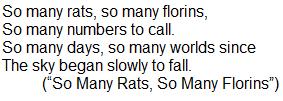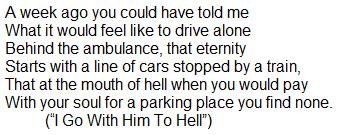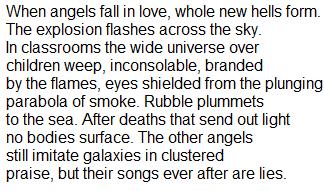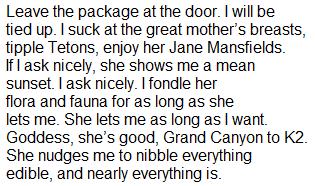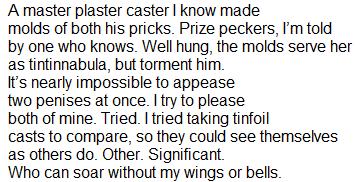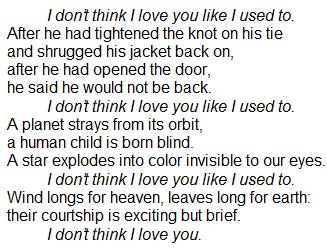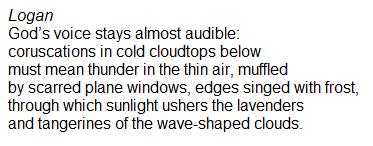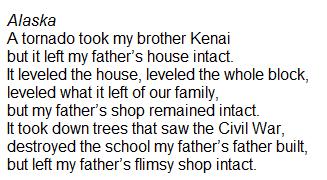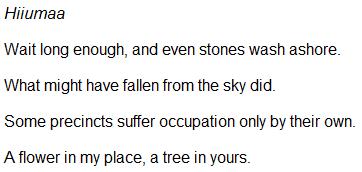As Easy As Lying: Essays on Poetry by H. L. Hix. Etruscan Press, 2002. 148 pps., $17.95
Surely As Birds Fly by H. L. Hix. Truman State Press, 2002. 72 pps., 14.95$
Rational Numbers by H. L. Hix. Truman State Press, 2000. 64 pps., 15$
Perfect Hell by H. L. Hix. Gibbs Smith, 1996. 80 pps., $9.95.
As Reviewed By: Marc Pietrzykowski
For those of us who have followed the poetry of H. L. Hix over the last decade or so, the source of his poetics has always seemed fairly clear: by yoking together the stylistically divergent approaches of New Formalism and Language poetry, he has endeavored to manufacture a style that transcends the limitations of either school. When his project is successful, as it is when he least concerns himself with asserting its validity, he bypasses the limitations of either school by creating a sort of hybrid of the two, one that has allowed him to gradually erase the suture-marks between its constituent parts with each succeeding title. When the project fails, however, it reveals enough of the operating principles behind its construction so as to reduce even the better poems to mere illustrations of the mechanics of his project. With the publication of As Easy as Lying, a hodgepodge of essays and reviews, Hix’s grand zeugma is given a more schematic outlay—one that spells out in tight, murky prose why he hopes to alloy (to use his term) the two poetic schools, and what elements of each have the greatest value to his project.
A central supposition of Hix’s poetics is that New Formalism and Language poetry continue to represent, for people who pay attention to such things, opposite ends of the contemporary poetic spectrum. One need not agree with this, necessarily, to enjoy Hix’s work; certainly the fact that both schools are overwhelmingly concerned with technique has already encouraged the argument (as put forth by the American poet and critic Lynn Emmanuel, among others) that they exist as elements of a single poetic concern, rather than as the poles of poetic utterance, but the dubious novelty of Hix’s argument is secondary to proper appreciation of his poems and prose. His belief in a certain formulation of postmodernism, and his apparent belief that the term “postmodern” still has some relevance at this point in history, is more troubling, however, as there exist at least as many postmodernisms as postmodernists, and the term itself seems to have lost much of its connection to a rejection of modernism and instead has become a portmanteau word meaning “functionally associative,” or perhaps “laterally trendy,” or maybe just “very, very, very modern,” as when used by the anchors of Entertainment Tonight.[private]
Still, the term has relevance for Hix, and so he isolates and identifies a set of concerns that serve as postmodernism for him, and these concerns serve as one of the root cuttings for the hybridization project outlined in “New Formalism among the Postmoderns”:
New Formalism and postmodernism might seem at first glance antithetical, and since “postmodernism” as the older and more catholic term, enjoys (or suffers) wider use in academia and in popular culture. New Formalists have been tempted at times to individuate New Formalism by opposing it to postmodernism […] but assume instead that, as New Formalism taps a richer vein than postmoderns such as Marjorie Perloff opine, so postmodernism holds more ore than New Formalists such as [Kevin] Walzer acknowledge: then the antithesis dissipates, freeing New Formalism to learn from its elder.
Or not; again, the argument that New Formalism and Language poetry (the sort of postmodernism Hix refers to) have congruent stylistic concerns is, well, a bit obvious, but the use of rather vague language in the paragraph above (does not the richness of a vein depend on the amount of ore therein? Does postmodernism have a gravel pit somewhere that ore is stored?) only makes things seem far more complicated than is necessary. Other pieces in this curiously amalgamated collection suffer from similar obfuscation, traversing personal memoir (“First Books”), baldly conventional explication (“Abstraction’s Command”), and even a strangely crooked encyclopedia entry (“Poetics”), with the same nagging quality of unenviable cerebrallity, of an intellect whose blessed rage to present itself as orderly and incisive renders the products of its expression hazy and indistinct.
In Perfect Hell, Hix first presented his project’s framework in a sonnet-heavy sequence that begins with a list of sources for many of the titles—a device readers will find either fascinating, pointless, pointedly pretentious, or, most likely, all three. Certainly, flipping back and forth from poem to attribution is revealing if you have some familiarity with the work cited (and it does not detract from their value, on the whole, if you do not) but the poetic gesture involved is, well, what one might expect from a first book—a plea to be taken seriously. Rational Numbers, Hix’s second book, also uses a list of attributions, while Surely As Birds Fly, his most recent book of poems, begins with a more self-assured acknowledgment of some of his sources of inspiration, and this particular arc—from nervous, awkward, and brilliant to relaxed, confident, and brilliant—provides a general description of how his work has progressed.
That first book, Perfect Hell, is clean and angular as an archaeopteryx skeleton, with metered, formally experimental poems using the unit-unit-unit cadence of imagery favored by Language poets. The fact that many of the more anaphoric and exergiasic poems resemble children’s rhymes says more about the false novelty of Language poetry than it does about Hix’s work, and in fact these poems succeed rather more frequently than those that allow more conventional narrative strategies to determine their meaning. The reason for this has to do with Hix’s hiccups of cliché. These moments of highly conventional verbiage help anchor the otherwise annoying, overworked associational tropes characteristic of Language poetry (which suffers not so much from a dissociation of sensibility as from a belief that actively rending sensibility will somehow rescue our culture from the effects of marketing) while cluttering more conventional narrative schemes with flattened, clunky language. As interesting as it might be to think about how cliché enriches the unconventional:
while flattening the conventional into sentimental caricature:
this device cannot hope to buoy a book-length work, let alone a career, and indeed Perfect Hell has many other charms to recommend it, but the sharpest moments of focus rely on the sudden appearance of conventional language and techniques, as when Hix’s rhymes yoke disparate elements in surprising ways:
Instead of an alloy, then, Perfect Hell seems more like a mold the alloy might eventually fill—a series of objects not, as yet, yoked together by their subject (the author) in such a way as to allow him to get on with the work of making poetry.
Still, one can sit with the poems in Perfect Hell a long while without feeling entirely annoyed at the way their method of construction fails to disguise itself, as is the case almost immediately with the “Orders of Magnitude” sequence in Rational Numbers, his second book of poems. Consisting of one hundred ‘decimals’, stanzas of ten decasyllabic lines (immediately calling to mind Peter Reading), “Orders of Magnitude” stretches the associative cadences of Perfect Hell across blocks of text whose structure, while predetermined, seems intentionally arbitrary. The goal seems to have been the creation of interesting, associative relationships between decimals, similar to those that cropped up between individual lines in Perfect Hell, but in trying to extend the project across a much wider space, Hix’s fluid little narrative loops chafe against the rigid arbitrariness of the poem’s form, causing it to ossify into helpless little nuggets of language. Individual decimals retain the jarring brilliance of the best of Perfect Hell:
and perhaps hopping haphazardly from episode to episode is a legitimate way to read “Orders of Magnitude,” but the form ultimately demands one assess the work as a whole, and proceeding from decimal one to one hundred is an experience akin to placing your ear against a motel room wall and hearing Vachel Lindsey drunkenly assault Gertrude Stein with a bass drum mallet. While not exactly monotonous, neither is the decimal form practicable for an extended piece at this point in Hix’s career, and whatever delight one of the more wonderful stanzas supplies quickly fades into the bleary, staccato fuzztone of the next, draining even the more goofily sexual of the decimals of vigor. Decimal fifty-eight, for example, is funny on its own:
but Hix follows it with a decimal that tries so hard to do exactly the same thing, it makes one embarrassed for laughing in the first place:
and so the scatological becomes just another device, another aspect of the project Hix has undertaken. Of course, we should judge poets by the quality of their obsessions, and so we might commend Hix for his ambition in the case of “Orders of Magnitude,” were it not for the fact that the second section of the book, the sprawling-yet-terse “Figures,” manages its own ambitions and repetitions in a much more dynamic, intriguing way.
Among the reasons the “Figures” section succeeds is Hix’s use of dialogue, a welcome change after the numbing monody of “Orders of Magnitude.” This technique manages to humanize his project without sacrificing certain general assumptions of the postmodern tradition: narratives are really cacophonous, multiple voices jockeying for meaning, and these conversations work across space, rather than time. The project itself recedes, and the voices themselves assume centrality:
And so the impressionistic and the anaphoric merge to serve a purpose greater than simply yoking together disparate techniques; in “Figures,” then, we get the first real glimpse of the ‘alloy’ Hix spoke of—the fruits of his zeugma.
The fact that the section of “Figures’ quoted above is built from the shadow of a rondeau might seem an appeal to tradition, but tradition, according to Hix’s particular postmodern view, is actually a set of texts we read and draw from contemporarily or, to use the term Hix favors, spatially. This idea, and the postmodern rejection of ‘master narratives’ in general, simply refocuses the terms of the argument in favor of skepticism and local experience. To say that the specters of Crane, Roethke, Dylan Thomas, Mother Goose, and many other ‘texts’ haunt Hix’s work is another, perhaps more accurate way of citing his influences, but only because he has decided to rename the terms by which he performs the apparently tawdry task of synthesizing and eluding the local influence of these (and many other) texts—and how else does one arrive at poetry?
Eventually, whether one thinks Hix is simply disguising a more traditional relationship to his influences with a veil of jargon, or else believes that he has truly managed to approach them in a new way is a moot (though interesting) point, since we can only judge him successful if he writes successful poetry, not by the way he chooses to describe the process of reading and writing it. Thus the poems in Surely As Birds Fly represent a step forward in many ways, as they display the sort of growth we associate with a poet moving comfortably beyond his struggles with influence. Unfortunately, this very progress sheds an unfavorable light on many of the essays in As Easy As Lying; by repeatedly analyzing the objects of his zeugma in his essays—insisting that the congruencies of Language poetry and New Formalism can be harnessed to produce worthwhile poetry—while presenting these (and other) arguments in prose that seems designed to distract rather than illuminate, he succeeds only in refocusing attention on the bare and simple guts of his project, on the decidedly narrow set of parameters he seemed to have moved beyond in Surely As Birds Fly.
The first and final sections of Surely As Birds Fly, “A Study of Thermodynamics” and “A Manual of Happiness,” revisit many of the techniques and themes of Hix’s previous books, but with an ease of construction that makes them readable as poems, rather than as evidence of ongoing ideological hybridization. “A Manual of Happiness” folds sizable chunks of conventional storytelling and multi-voiced lyric together deftly and compellingly into a sort of travelogue, with instances of virtuosity flaring up when the dramatic need arises:
and again:
While the poet of Perfect Hell still lurks in the structural principles underlying these selections, his importance has become a matter of secondary concern.
“A Study of Thermodynamics” and “A Manual of Happiness” represent the sort of synthesis that eluded Hix in Rational Numbers, while “Thistle, Clover, Rape,” the central section of Surely As Birds Fly, succeeds on less grand a scale, but then it is a sequence done in a minor key, stacking lines and images atop empty space and one another in a manner that recalls Rational Numbers, but with an essential quietism that book lacked:
Many of the poems in “Thistle, Clover, Rape” possess a meditative quality that brings to mind the “One Hundred Haiku in Free Form” of Ozaki Hosai. Hix tries something similar in the final essay of As Easy As Lying, “Toward a Prodigal Logic,” aligning blocks of text left, right, and center in order to, one would suppose, undercut our assumptions regarding argumentation and the structure of the modern essay. The essay fails, however, where the poems in “Thistle, Clover, Rape” mostly do not, because “Toward a Prodigal Logic” tries to circle around meaning without lighting upon it, and the poems mean because they are essentially uninterested in producing meaning. This final essay, in fact, returns us to the dictates of Hix’s poetic project with such violence that it pushes the poetry away and necessitates a bit of rest. Sequences such as this one:
while not permanently injurious to Hix’s poetry, are enough to make the reader wary of any signs of straining toward aphorism, for it is at these moments that Hix’s poetic blurbs become sententiae, affirmations for those who already agree with his project rather than any real sort of experimentation, an effect described by Gordon Williams as depending “…on the writer’s capacity to make the reader view it as an acceptable frame work for analysis, even to see it as an imaginative interpretation or extension of experience so that a pleasant sense of expectation is aroused.” The sense of expectation aroused by the oddly formatted text and parsed bits of abstraction is thwarted by the desire of the individual sentences to resemble wisdom the way a koan does, and so the entire project collapses through its inability to be either experimental or pithy enough.
What As Easy As Lying does offer is a rather broad explication of Hix as contemporary poetic figure, and of the zeugma he has chosen to base this identity on; still, one has but to read through his poems to see how fine they become once his need to establish this identity subsides. Several of the essays deal with the health of New Formalism, and since Hix does experiment primarily within the class of prosodic concerns—regularity, economy—that New Formalists have laid claim to, they give sensible prognosis, but hasn’t the sobriquet “New Formalism” by now eluded cohesion as totally, if with not as much girth, as Postmodernism has? More poets pay better attention to, and experiment with, traditional formal concerns than did before the New Formalists addressed the need, but there seems little point in announcing your allegiance to a poetic agenda unless you have some larger axe to grind with the world, as folks like Joseph Salemi have made quite clear (in one characteristic rant, he accuses Hix of “Marxist-inspired delusion”).
Advocating for traditional approaches to history and tradition is a project whose pitfalls are well-documented, as is championing the contemporary, though we forget; perhaps it is this instinct toward ideology that needs to take a back seat while we all take a good look around. As the poems in As Surely As Birds Fly demonstrate, humility in service of the greater good—poetry—allows for a greater variety of ambitions, which in turn produces far more superior verse than does furthering one’s agenda through the medium of poetry, let alone asserting that adherence to one school or the other, or some hybrid thereof, is the key to poetic excellence. Hix’s ambitions have always seemed more substantial than simply becoming a figure of future historical interest (“oh, you mean the guy that put New Formalism and Language poetry together”), and now that he has accomplished his project, perhaps he can let it alone.[/private]

